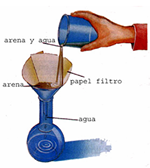Actividad 2
Methods of separating homogenous mixtures: filtration and decantation
We make many mixtures, like the ones in the food in the previous activity. Some mixtures are already” prepared.”
Can you think of some? There are lots in your house! Toothpaste, the paint on the walls, almond ice-cream, deodorant, glue,
washing up liquid, paper, clothes fabric, etc.
So, is it possible to obtain the original components of a mixture?
Think again about the salad. What happens if we don’t like the onions? We can remove them with a spoon
or fork. But it’s not always so easy. How would you remove the sugar from juice, if it was too sweet?
There are different methods to separate mixtures. We are going to analyse some of them.
Image from:
http://medusa.unimet.edu.ve/
educacion/fbqi21/matraz.jpg
Activity
Filtration: is used to separate a solid substance from a liquid, normally, tiny solid particles
which are dispersed in a liquid. The process is simple. The mixture is passed through a filter which lets the liquid pass
but retains the solids.
You have seen filtration in your house many times without realising it. For example, when you use a strainer to separate
the pulp to make juice or a colander to strain the water from pasta.
Decantation: is used to separate liquids with different densities. The mixture is left for the
necessary time for the two components to separate (the densest liquid will sink). A decantation funnel with a stop cock is
then used. When the stop cock is opened the densest liquid falls out and the stop cock is closed when all the liquid has fallen.
In this way, the two components are separated.
EXPERIMENT
We are going to use these methods to separate some mixtures. Divide into groups of four or five members.
You will need these materials:
- Fine sand.
- Oil.
- Filter paper
- A funnel
- A beaker
- A decantation funnel
- A support
- A glass
- A small plastic bottle
Throughout the experiment you need to record a video of the procedures.
First, we will make the mixtures:
- Put water and fine sand in a glass and mix well
- Fill a small plastic bottle half with water a half with oil.
Record how you make the mixtures.
Now we have to separate the components. How?
For the sand and water mixture we will use the method of filtration. For the oil and water mixture we
will use decantation.
Separation of sand and water. We are going to separate the water and the sand. As shown in the
diagram, put the filter paper in the funnel and support it over a beaker. Whilst some of you set up the experiment, others
need to record the video and make notes of the procedure, for a presentation, later on.
When everything is prepared, pour the sand and water mixture into the funnel and wait until all the water falls into the
beaker and the sand stays in the filter.
source of the image: http://3.bp.blogspot.com/
_LruEWdsfuaI/SnDke5St27I/
AAAAAAAAADQ/YeieTm-QZfQ/
s400/filtraci%C3%B3n.jpg
Separation of oil and water .
We are going to separate oil and water. If you don’t have a decantation funnel you can make one by following the instructions
inhttp://centros5.pntic.mec.es/ies.victoria.kent/Rincon-C/practica2/pr-53/PR-53.htm
Like before, some of you need to set up the experiment, others need to record the video and make notes
of the procedure, for a presentation, later on.
In all the experiments you must be careful. Treat the material with respect, don’t make brusque movements and be patient.
For example, you may have to wait for the oil and water to completely separate in the decantation funnel.
First, we pour the mixture into the decantation funnel and wait for the oil and water to separate.
When they are separated, place a beaker under the decantation funnel and open the stopcock.
Let the first component out. Can you identify which one it is?
When all the first component is out, close the stopcock, change the beaker and open the stopcock again.
In the end, we have two beakers, each with one component.
Do the following exercise: True or false.


















